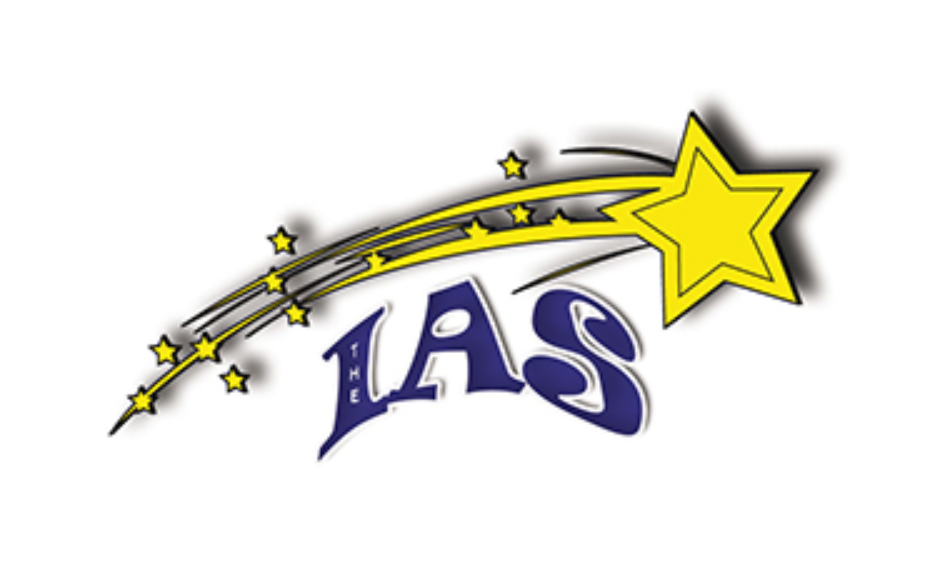
(The 3D Cards help to support my STEM visits. The more I sell, the more STEM school visits I can do).

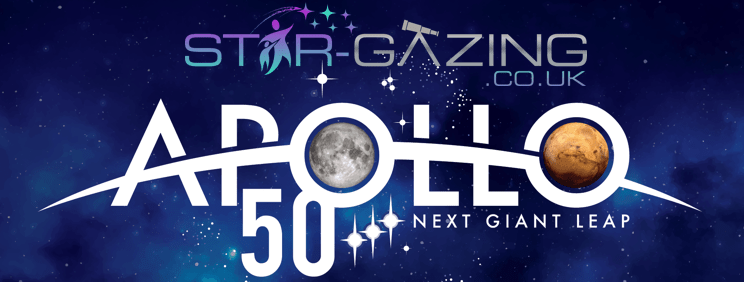
It’s a busy day for the 3 astronauts aboard Apollo 12, 50 years ago today – 14th November 1969.
The crew are:
Pete Conrad – Commander.
Dick Gordon – Command Module Pilot.
Alan Bean – Lunar Module Pilot
The launch of the mighty Saturn V rocket was at 16:22 from Cape Canaveral.
36.5 seconds after launch there was an electrical disturbance, followed by another one 52 seconds after launch.
The Saturn V had been struck by lightning. Twice!
Luckily all systems were still functioning normally, so the ascent towards Earth orbit continued.
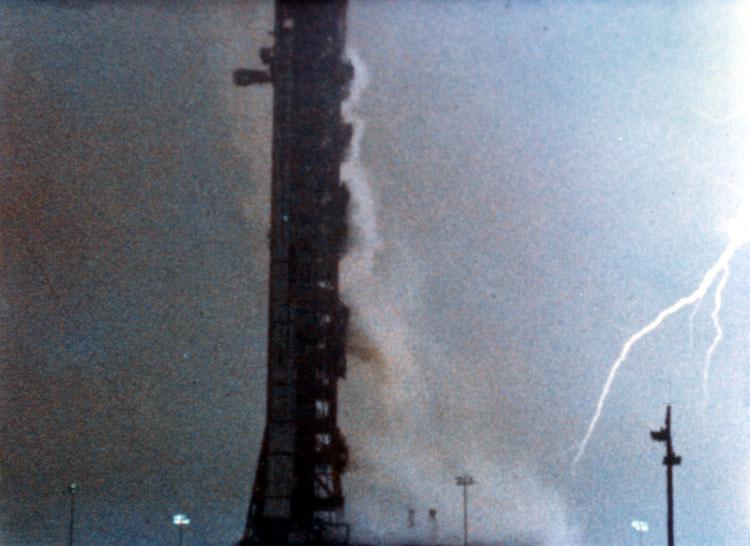
At 2m 41s into mission, the first stage cut off, separation occurring one minute later.
The five-engine second stage cut off at 9m 12s, separating at 9m 13s.
The single-engined third stage (S-IVB) burned from 9m 16s until 11m 33s into the mission.
This placed the Apollo spacecraft into an elliptical Earth orbit.
The orbit of the Apollo stack was adjusted and trimmed by the third stage by firing a second time from 2m 47s until 2m 53s.
Now a big decision had to be made.
Had the lightning strike affected the Apollo spacecraft on launch?
Could the parachute deployment system at the nose of the Command module have been damaged?
Could the heat shield on the back of the command module have also been compromised?
As they were already in orbit, the only way to test these out were by using them.
This would involve aborting the mission and bringing the astronauts home now.
The other option of course was to send them onto the Moon and test these once they got back to Earth 10 days later.
Thankfully all extensive checks on the spacecraft now made while safely in Earth orbit showed that everything was working nominally.
As a result clearance was then given to “go for TLI” (Tran-Lunar Injection).
2 hours and 50 minutes into the mission, the third stage engine was fired for a third time to increase the velocity to about 25,000 mph.
This will send them into a highly elliptical orbit around Earth, sending them towards a spot in space, passing close to where The Moon will be in 3 days time.
At 3h 18s The Command Module Pilot Dick Gordon un-docked the Command Module (Yankee Clipper) / Service Module from the third stage to performed the transposition, docking and extraction procedure to remove the Lunar Module called Intrepid from atop the third stage. This was revealed when the panels fell away.
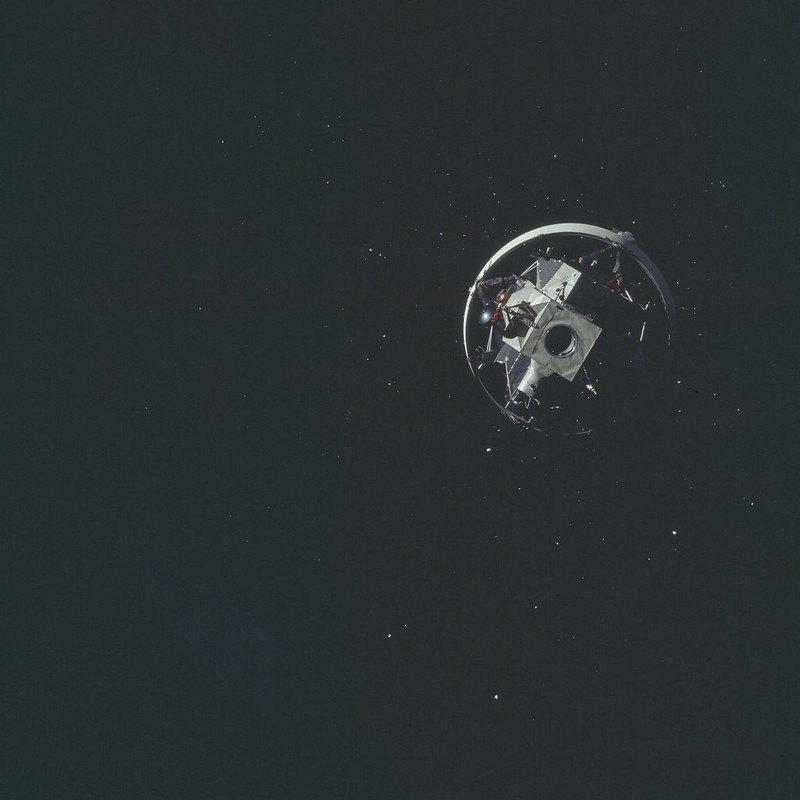
Once the Lunar Module was extracted the Command/Service Module moved away from the spent third stage.
After separation most third stages were crashed into the Moon’s surface.
This enabled them to test the instruments left my Apollo 11 which measured Moonquakes.
In Apollo 12’s case, the third stage entered into a strange solar orbit.
This orbit periodically brings it back towards Earth.
It was last spotted in 2002. It is due to come back near to Earth in 2032 and may be bright enough to be visible to amateur observers / imagers. Also catalogued as asteroid J002E3, its Apollo origin was confirmed when spectroscopic studies showed a signature matching that of the titanium oxide paint used on the rocket.
At 4h 20m into the mission an avoidance manoeuvre was performed to ensure they separated from the third stage.
The three astronauts then started their coast towards an area of space where they will meet up with The Moon in 3 days time.
They performed a TV transmission and at the end of the day The Lunar Module Pilot, Alan Bean entered the Lunar Module to start checking all its systems were OK in anticipation of the landing.
It was a great start to yet another lunar adventure for the second Moon landing.
Well today could be a great day (or not). But it could be a day of two halves.
If the rain clouds flooding the country relent, we could hopefully view the transit of Mercury which starts just after 12:35 today until Sunset. That’s good, as long as the clouds part so we can view it.
See my details of that event here:
https://www.star-gazing.co.uk/WebPage/mercurytran-20191111
However, there is another event taking place today which doesn’t appear to be getting a lot of attention at the moment.
Elon Musk’s SpaceX is launching another Starlink cluster today.
This might not be as good.
The launch is scheduled for 14:56 UT, while the transit is in progress.
A backup launch windows is scheduled for 14:34 UT tomorrow (12th).
The launch of the Falcon 9 rocket can be viewed live here: spacex.com/webcast.
60 new Starlink satellites will be put into Earth orbit.
Once the satellites are in orbit, you may want to produce predictions for visibility from your location at:
https://n2yo.com/passes/?s=74001
It could look spectacular as the cluster catch the sunlight if the last launch is anything to go by.
But is the launch of these satellites going to be a really bad thing for us observers / imagers going forward?
See my previous blog entry about what this new constellation of satellites could mean for our night sky:
https://www.star-gazing.co.uk/WebPage/starlink-spectacle
Dave
On the evening of the 7th of November I will be re-visiting Walsall Astronomical Society.
http://www.walsallastronomy.co.uk
Nicely timed just before the Mercury Transit next Monday (11th November) I will be talking about Solar Astronomy.
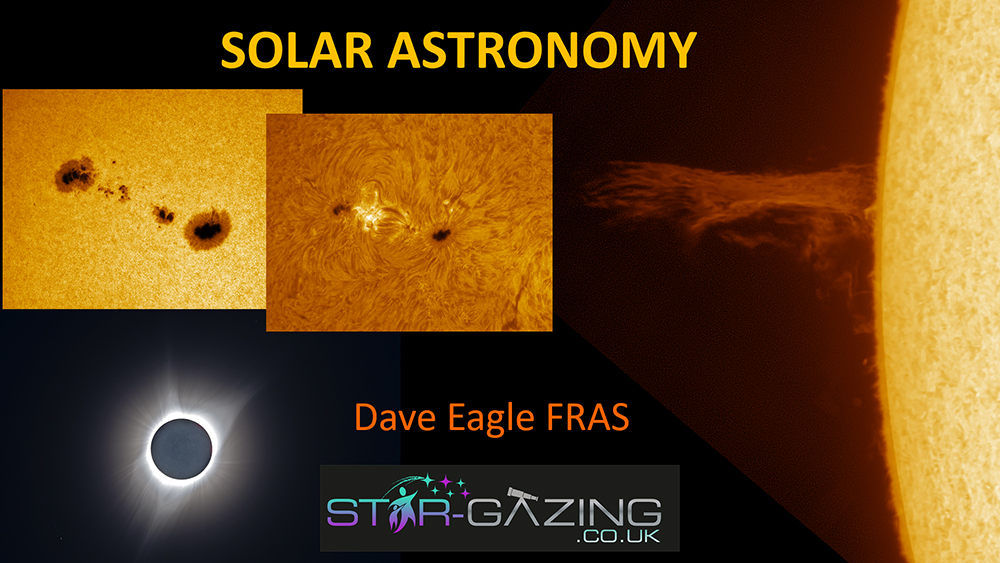
This will show what an amateur can achieve these days with the correct and safe solar equipment.
It will also give lots of details about the upcoming transit event and what we are likely to see from the UK (Probably clouds!).
Walsall Astronomical Society meet every Thursday at:
Rushall Olympic Football Club,
Dales Lane (off Bosty Lane),
Rushall,
Walsall.
WS4 1LJ
Cost:
Members £2:00
Visitors £1:00
My penultimate free monthly sky diary for November 2019 showing the events of the night sky visible from the UK is now available in a printable pdf version for download.
Click here, or on the image below to download the pdf.
After 32 years of doing my sky diary, I will stop producing this after December.
It’s been a sad, and big decision for me to do this, but it is getting difficult to fit it in with my many other commitments.
However, it’s all not bad news.
All my sky diary events are currently and will in future be added to the UK Cloud Magnets online calendar.
I will still keep this as up to date as I can and add new information as I hear about it.
Click here to view the UK Cloud Magnets online calendar.
I will also be updating my blog (www.star-gazing.co.uk/Blog.html) with any new information on sky events as appropriate.
On Monday the 28th of October I will be visiting Abington Camera Club https://wpsite.clubabington.org.uk to present:
A Whistle-Stop Tour of the Universe (Hitch-Hiking on a Ray of Light).
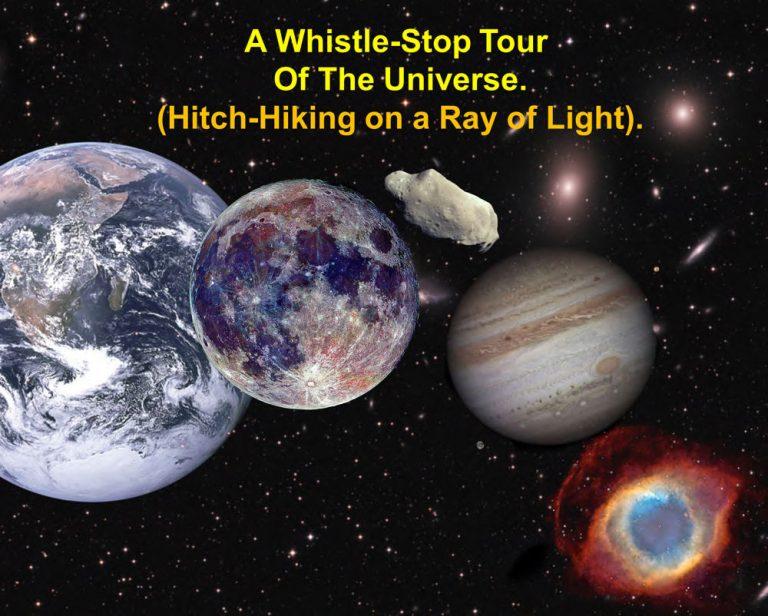
So let’s hope that they strap themselves in and brace themselves for a journey that really is out of this world.
Of course, it’s just a really fantastic excuse to show lots of beautiful images of our wonderful universe.
So if you are in the area come along and say “Hello”.
Abington Camera Club meet at:
The Community Centre,
Wheatfield Road South,
Abington,
Northampton
Meeting Starts at 7:30pm.
On the 7th of October I will be re-visiting Aylesbury Astronomical Society.
Talking about:
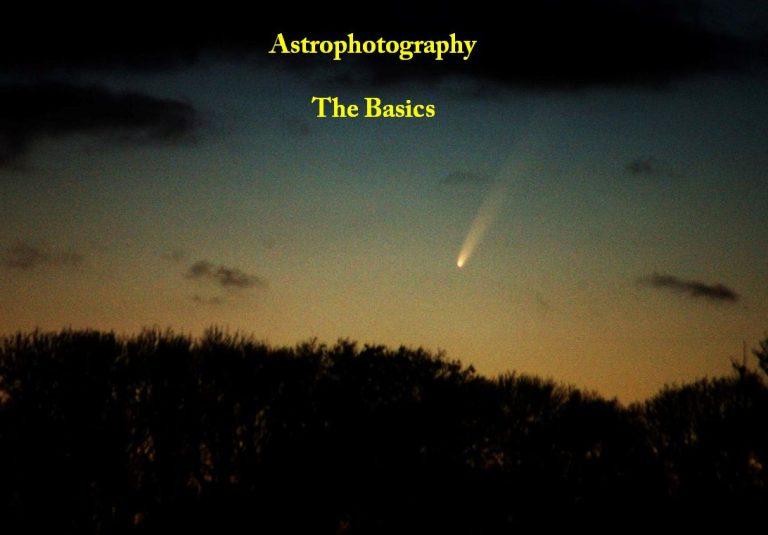
Aylesbury AS meet at the 9th Aylesbury Scout Hut.
Oakfield Road, Aylesbury.
HP20 1LJ
Meeting starts at 7:30pm.
More details about Aylesbury AS are on their Web site:
http://www.aylesbury-astronomy.org.uk
My free monthly sky diary for October 2019 showing the events of the night sky visible from the UK is now available in a printable pdf version for download.
Click here, or on the image below to download the pdf.
Just to let keep you informed, after 32 years of doing my printable sky diary, I will stop producing my printable sky diary after December. It’s been a sad, and big decision for me to do this, but it is getting difficult to fit it in with my many other commitments.
However, it’s all not bad news.
All my sky diary events are currently and will in future be added to the UK Cloud Magnets online calendar.
I will still keep this as up to date as I can and add new information as I hear about it.
Click here to view the UK Cloud Magnets online calendar.
This and my Blog (www.star-gazing.co.uk/Blog.html) is where I will put any new information on sky events as they become known to me.
Tonight, I will be visiting the Open University Astronomy Club in Milton Keynes to present my:
Whistle-Stop Tour of the Universe (Hitch-Hiking on a Ray of Light).

So let’s hope that they strap themselves in and brace themselves for a journey that really is out of this world. Of course, it’s just a really fantastic excuse to show lots of beautiful images of our wonderful universe.
Unfortunately, Flat Tim won’t be attending this time!
So if you are in the area, come along and say “Hello”.
They meet at The Open University in The Robert Hooke Room.
Meeting starts at 7:30pm.
Details on how to find the venue are on their Web Page:
http://www.shindles.co.uk/ouastro/Where.htm
This weekend is the main Kelling Equinox Starcamp weekend organised by Loughton Astronomical Society.
Hundreds of like-minded astronomers meet up at Kelling Heath Holiday Park.
Some of them stay for more than a week to make the most of clear skies and a companionable weekend.
I can’t make it this year, so sending everybody attending fine weather for the event.
If you have been unable to get a pitch for this starcamp, there are many other across the UK.
Visit my Web page here for a list.
http://www.star-gazing.co.uk/WebPage/resources/list-uk-star-parties
If I have missed any out, please let me know.
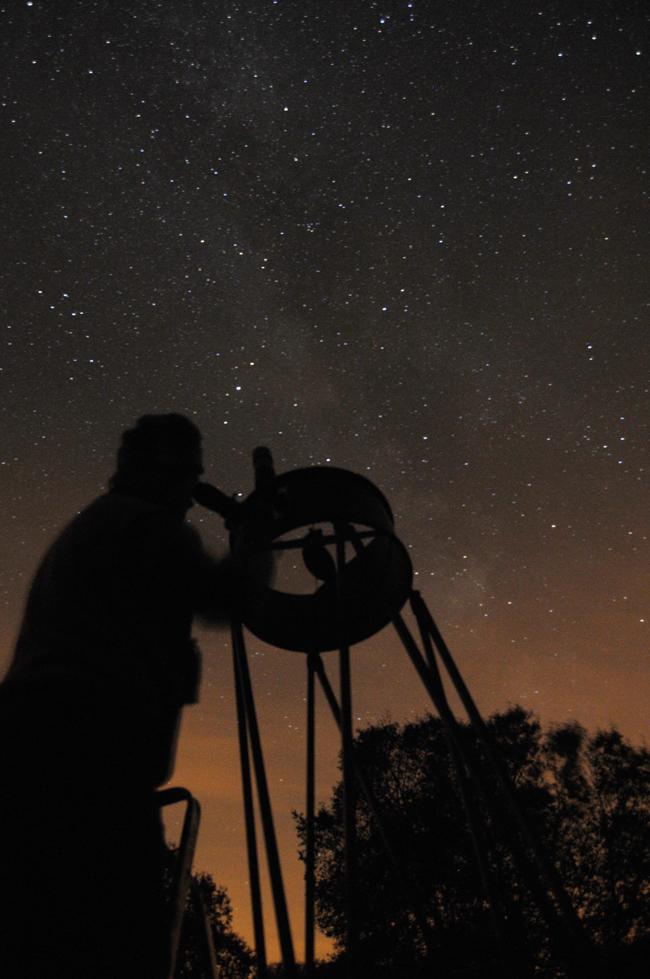
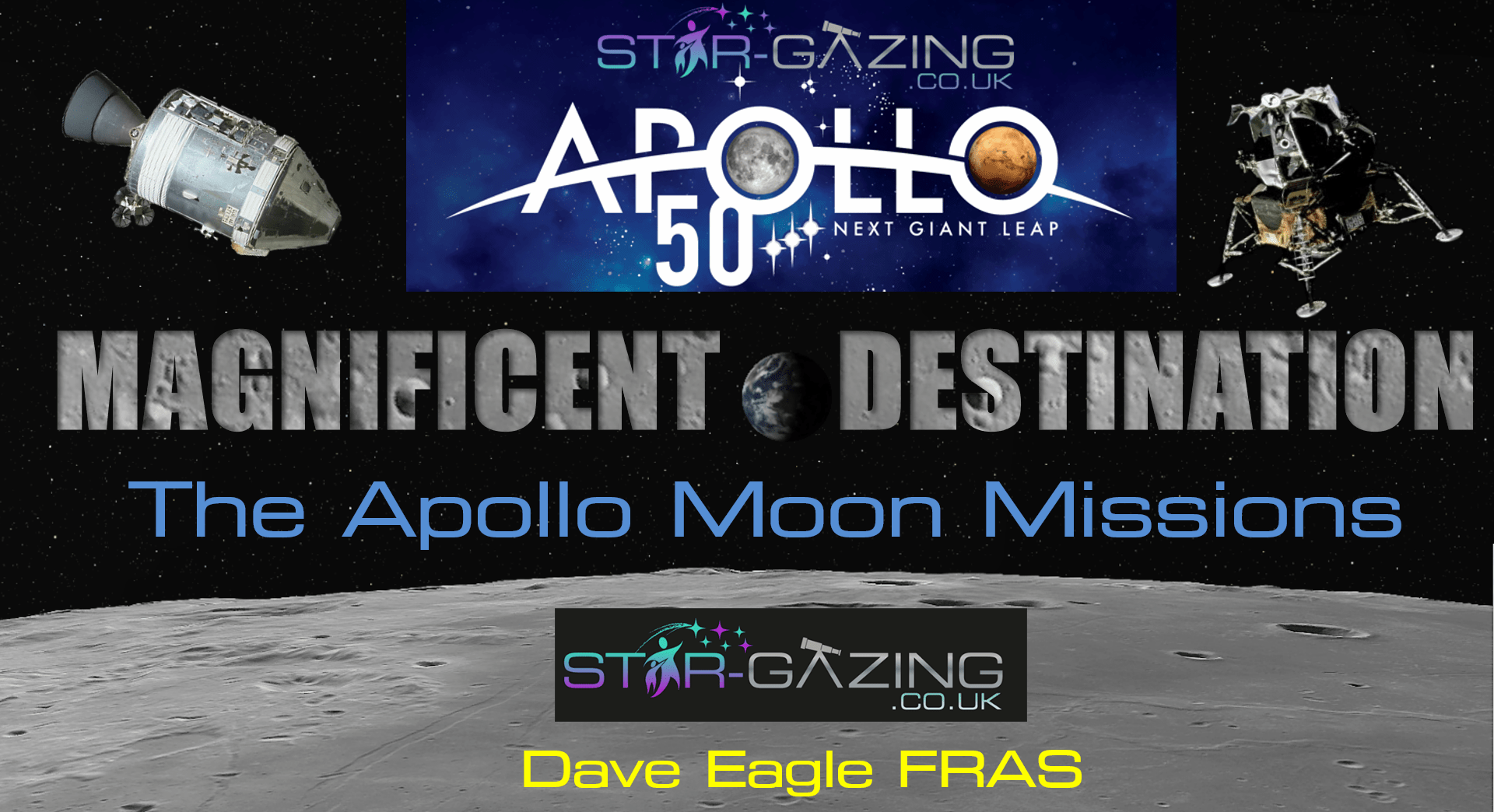
If you are in Kidderminster on the 1st of November, I am presenting two Apollo 50 events for both Kidderminster Arts and Food Festival (KAFF) and Go Space Watch.
The day starts with the KAFF event with an afternoon of fully-immersive planetarium shows.
These will tell you all about the Apollo 11 landing. Hold your breath as you sit on the Moon watching Neil Armstrong land The Eagle lunar module, with landing fuel running low.
Booking available using Paypal from my Web site:
http://www.star-gazing.co.uk/WebPage/planetarium/kaff-planetarium-shows
£4:00 per person.
For more information about KAFF, their Web page is here:
http://www.kidderminsterartsfestival.org.uk
This will be followed by an evening audience-participation presentation bringing the lunar landing missions to life:
Magnificent Destination: The Apollo Moon Missions.
Tickets for this Go Space Watch event are booked via the Eventbright Web site:
https://www.eventbrite.co.uk/e/magnificent-destination-a-presentation-about-the-apollo-moon-missions-tickets-73700533279?aff=ebdssbdestsearch
£3:00 per person.
The venue for both events is:
Kidderminster Town Hall.
Vicar St, Kidderminster, DY10 1DB.
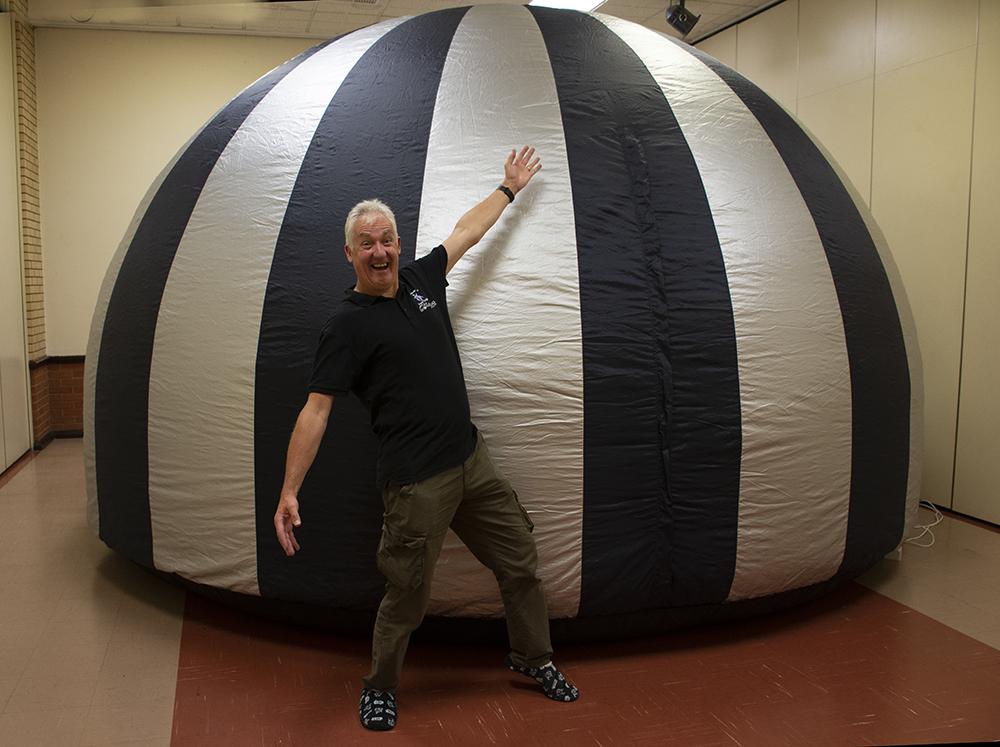
Comet C/2019 Q4 (Borisov) has crashed into astronomical news.
It is the second object known to have originated from outside our solar system, make a dive in towards The Sun and then speed it’s way out once again.
The first known interloper Oumuamua (Formerly 1I/2017 U1) was discovered in 2017, and got people all excited.
Many observations of the object determined that it was a highly elongated object, essentially cigar shaped, prompting many people to propose it may have been artificial and built by aliens (Ha Ha!). It is composed of metal-rich rock and reddened by compounds called tholins laying on it’s surface. These are the same compounds which also give the red colours seen on Pluto, Charon and Ultima Thule (2014 MU69), which the probe New Horizons visited in July 2015 and New Years day 2019 respectively.
Comet Borisov was discovered in August at a distance of 3 Astronomical Units from The Sun.
It appears to have approached our solar system from an area of sky located slightly to one side of the double cluster in Perseus.
The comet was magnitude +18 at discovery.
Unlike Oumuamua, Comet Borisov was found long before perihelion, when it will be at it’s closest to The Sun.
This occurs on the 28th of December.
This very interesting object will be studied intensely during its apparition by lots of professional astronomers.
But as an amateur observer / imager, what are we likely to be able to see or image?
The comet currently lies in the northern part of Cancer, and heading steadily south.
It moves past the Sickle of Leo during October, passing very close to Regulus on the 4th of November.
So some early mornings are required if you want to catch the comet.
The comet continues southwards bound, passing almost directly through the centre of the constellation Crater mid-December.
Perihelion is reached on the 28th of December. The comet will still be quite a long way from Earth at this time, so don’t expect miracles.
It is unlikely to become much brighter than +15th magnitude, so observations are unlikely with very dark skies and a decent sized telescope. Astrophotographers are more likely to be able to capture the comet and I will look forward to seeing some of these images as they are released.
Sounds like a great little project for me to try my hand at over the coming weeks.
Use the map below to work out where the comet is.
Positions shown at 5 day intervals at 0h on the dates shown.
(Please note, the comet’s path may change as the ephemeris is re-defined. I will update if I see any changes).
Click on the map below to see a bigger version.
Tonight I will be re-visiting one of my closest astronomy clubs to talk about astrophotography.
It will be good to catch up with my friends at Nene Valley Astronomical Society.

Nene Valley AS meet at the Village Hall in Chelveston.
Caldecott Road, Chelveston. NN9 5AT.
The doors will open at 7:30pm to start at 8pm.
Please use the door at the rear of the building.
£3:00 per person.

On Saturday the 14th of September the Federation of Astronomical Societies (FAS) are holding their annual convention.
This will be held at The Institute of Astronomy, Madingley Road in Cambridge.
The FAS Convention is a great day of interesting astronomy talks:
There is also a chance to tour the historic telescopes and be tempted to buy some nice astro gear from some of the trade stands.
The event starts at 09:45, finishes 18:00.
£8 for FAS members
£10 for non-members
£4 for juniors (members and non-members).
Book tickets from the FAS Web site:
http://fedastro.org.uk/fas/convention/convention-2019
Another comet that will be good to go out and watch is 260P (McNaught).
It is currently heading northwards in the constellation of Aries.
Images taken of the comet show it sporting a short but very distinct tail.
By the end of September the comet is in Perseus at about 11th magnitude, but still slowly brightening.
But it is not predicted to get very much brighter.
On the 8th and 9th of October the comet passes close to the open cluster M34.
The map below shows the path of the comet during September.
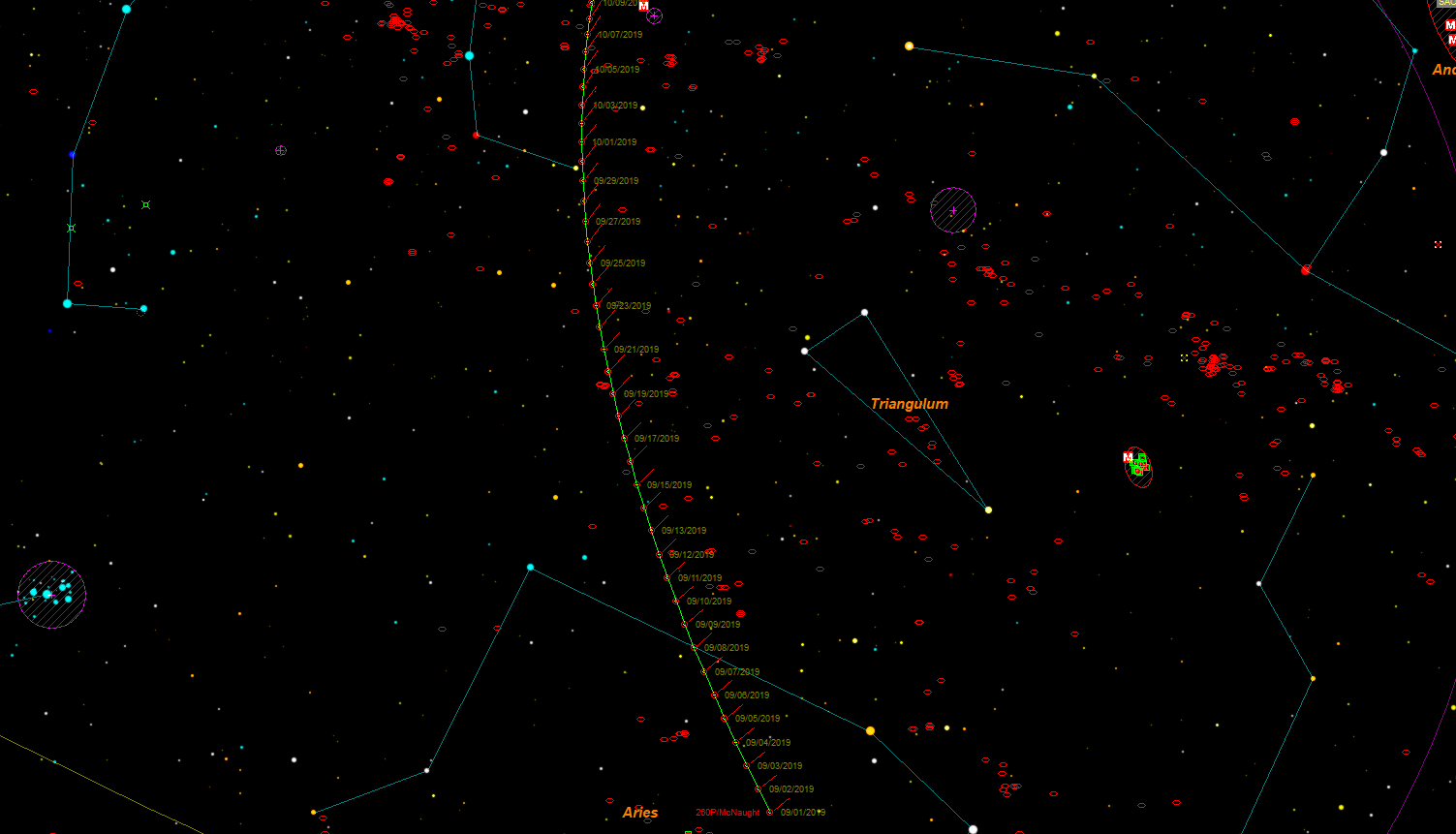
At the end of October and into November, the comet starts to trace out a retrograde loop.
The map below shows the path of the comet during October and November.
Comet 2018 W2 (Africano) is visible the next couple of months.
It is fairly high up at the moment in Perseus.
It reaches perihelion tomorrow (6th September). It is currently about 10th magnitude.
So it does require a reasonably sized telescope or imaging to pick it out.
The path of the comet takes it from Perseus and mid-month it moves into Andromeda.
On the 17th & 18th it passes almost directly between the galaxies M31 and M33.
The map below shows the path of the comet during the first half of the month.
On the 22nd of September it passes fairly close to the bright naked eye star Delta Andromedae.
The comet should have started to fade by this time.
The map below shows the comet path at the end of September into early October.
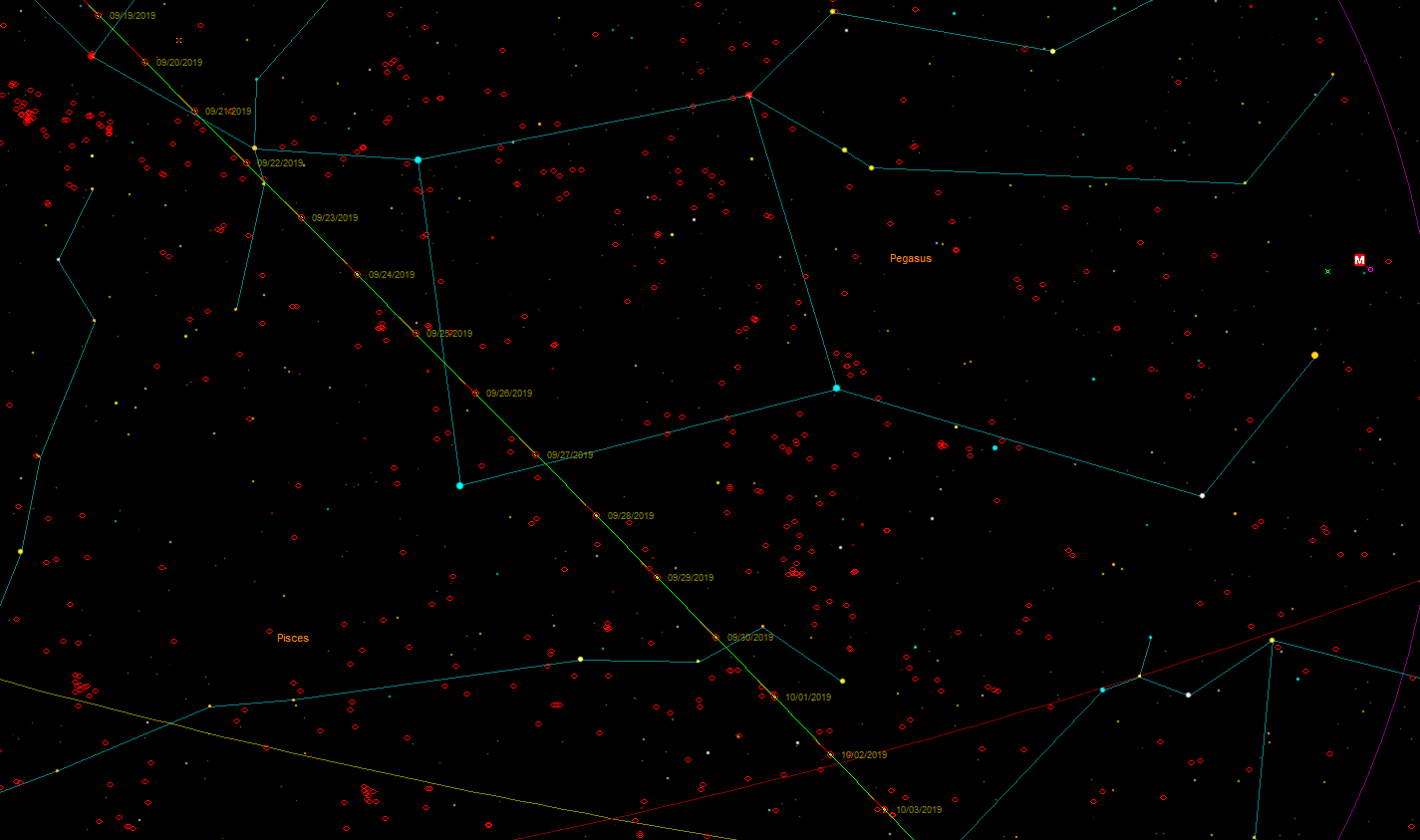
Around the 26th of September the comet passes through the bottom left part of The Square of Pegasus.
It continues heading southwards, fading all the time.
The map below shows the comet path during mid-October.
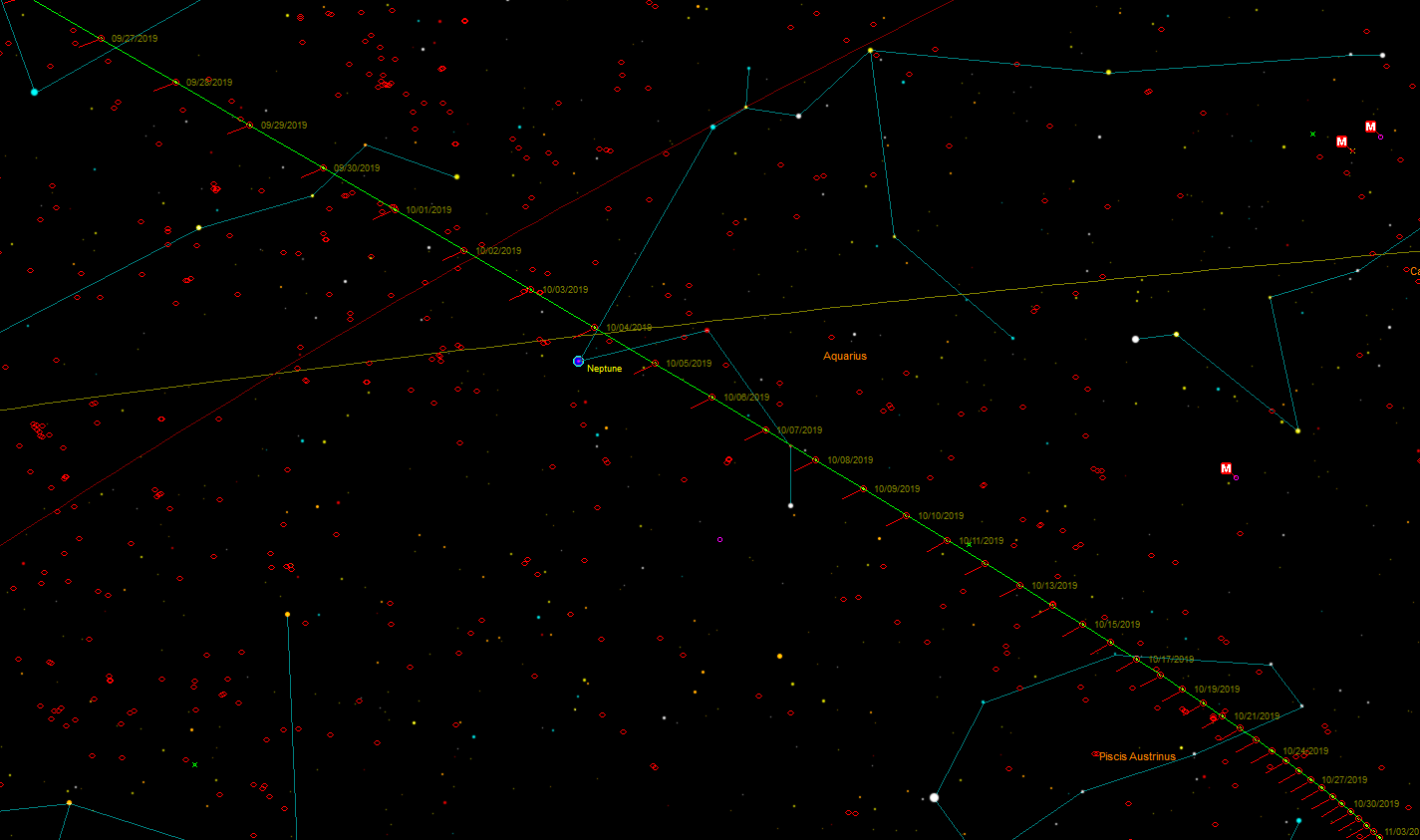
On the 4th of October Comet 2018 W2 (Africano) passes fairly close to Neptune.
It would be good if these two objects could be captured in a single image.
The last map below shows the comets path at the end of October and into November, where it should have almost faded from view and is starting to trace out a long retrograde loop.
Happy Hunting.
Tonight Duston Camera Club have invited me to present my
Whistle-Stop Tour of the Universe (Hitch-Hiking on a Ray of Light).

So let’s hope that they strap themselves in and brace themselves for a journey that really is out of this world.
Of course, it’s just a really fantastic excuse to show lots of beautiful images of our wonderful universe.
So if you are in the area come along and say “Hello”.
Meeting Venue:
Duston Community Centre
Pendle Rd, Northampton NN5 6DT
My free monthly sky diary for September 2019 showing the events of the night sky visible from the UK is now available in a printable pdf version for download.
Click here, or on the image below to download the pdf.
Just to let keep you informed, after 32 years of doing my printable sky diary, I will stop producing my printable sky diary after December. It’s been a sad, and big decision for me to do this, but it is getting difficult to fit it in with my many other commitments.
However, it’s all not bad news.
All my sky diary events are currently and will in future be added to the UK Cloud Magnets online calendar.
I will still keep this as up to date as I can and add new information as I hear about it.
Click here to view the UK Cloud Magnets online calendar.
This and my Blog (www.star-gazing.co.uk/Blog.html) is where I will put any new information on sky events as they become known to me.
As the sky gets dark tonight, a transit of Ganymede’s shadow will be in progress, as will the great red spot.
The first two illustrations in the diagram below show the view at 21:20 UT.
Only 3 of the Galilean satellites are visible.
Io is to the east of Jupiter, but is hidden within Jupiter’s Shadow.
An hour later Io has emerged from the shadow and will be easily visible.
All four Galileans will be visible once again as seen in the lower diagram.
Ganymede’s shadow transit is still in progress and will move off Jupiter’s disk by 21:54 UT.
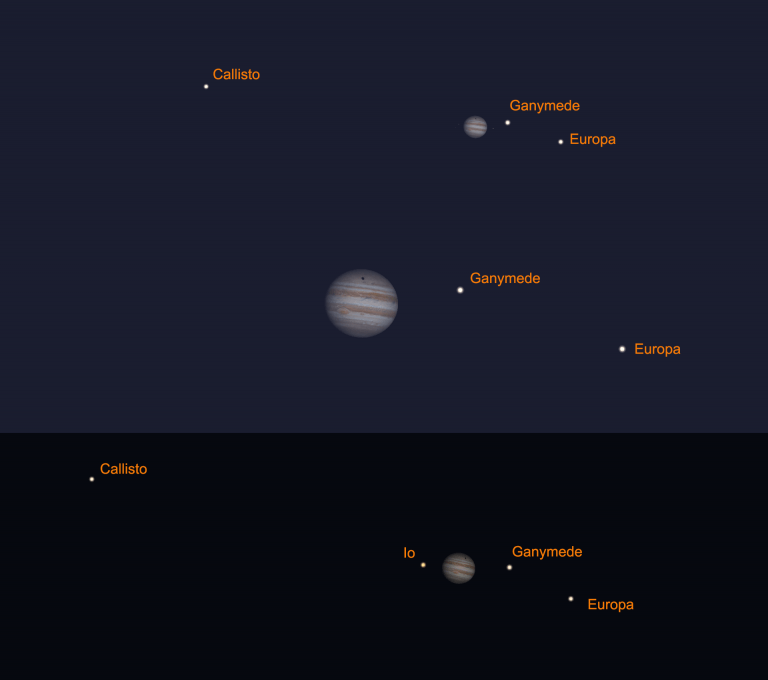
Tomorrow I am once again proud to be supporting the summer Space Chase Reading challenge,
I will be bringing the planetarium to Far Cotton Library in Northampton.
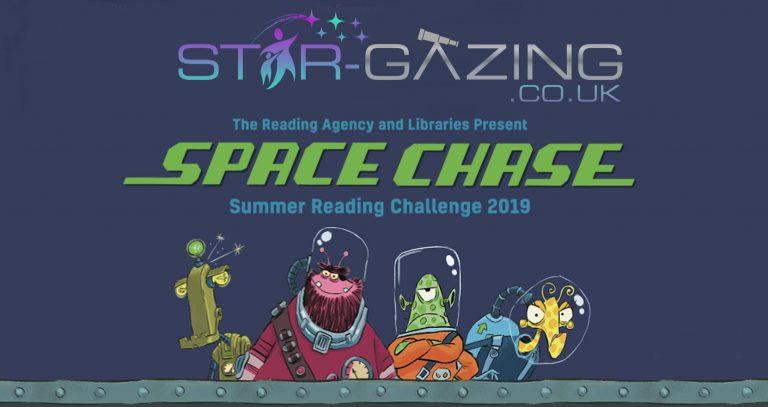
There are 4 shows throughout the day, so make sure that your child is booked into a show for this completely immersive full-dome experience.
It will take them on a journey around the wonderful planets in our solar system. Educational, Inspiring and most of all FUN!
As if this wasn’t enough, at the end of the show, Tim Peake takes you on a guided tour of The International Space Station.
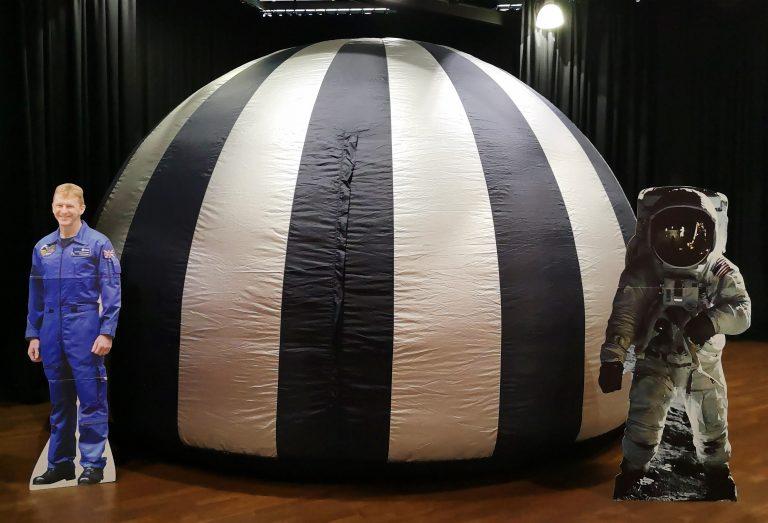
Tonight I will be re-visiting Rugby & District Astronomical Society.
I will be presenting, Magnificent Destination: The Apollo Moon Missions.
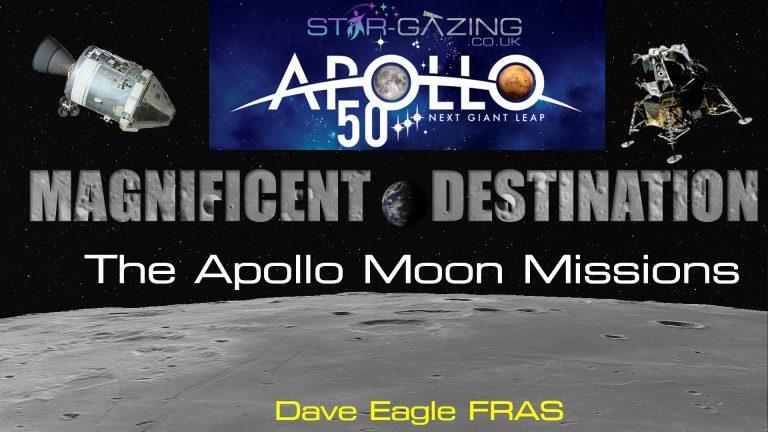
This tells the story of the fantastic Apollo missions and the landing of The Eagle, the Apollo 11 lunar module, on the Sea of Tranquillity 50 years ago last month.
It’s a story I am going to enjoy telling again after this presentation first aired on my Apollo 50 celebration day.
Ruby and District AS meet at:
Church Lawford Village Hall,
School Street,
Church Lawford,
Warwickshire.
CV23 9EE
Meeting starts at 7:30pm.
Today’s the day that the Apollo 11 mission finally concluded.
Mike, Neil & Buzz were finally released back out into the world after being in quarantine since landing. They could finally be reunited with their families.
It seems like a crazy notion, because if they had bought any moon bugs back with them, these would have been released into the air and water as soon as the command module hatch was opened in The Pacific Ocean.
Apollo missions 12 and 14 also went through this same ordeal.
More details about the quarantine are on the Sky At Night Web page:
https://www.skyatnightmagazine.com/space-missions/why-were-apollo-11-astronauts-put-in-quarantine/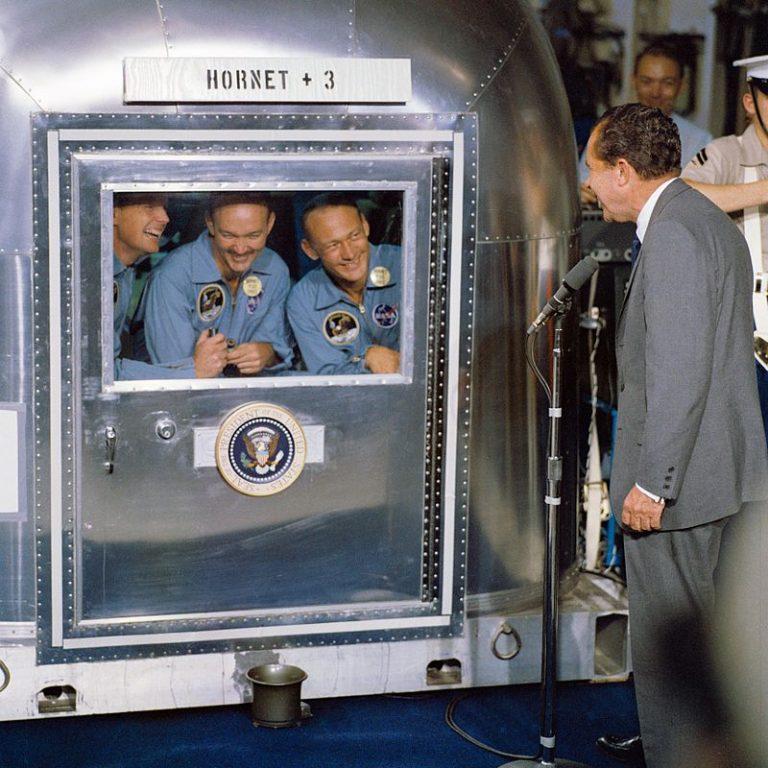
 The first event supporting the @Library_Plus Space Chase @readingagency #SpaceForReading challenge this summer was held yesterday.
The first event supporting the @Library_Plus Space Chase @readingagency #SpaceForReading challenge this summer was held yesterday.
Alongside other members of Northamptonshire Natural History Society (NNHS), we wowed them with not only astronomy and space, plus some pond life under microscopes as well.
The planetarium only just fitted, and almost swallowed me!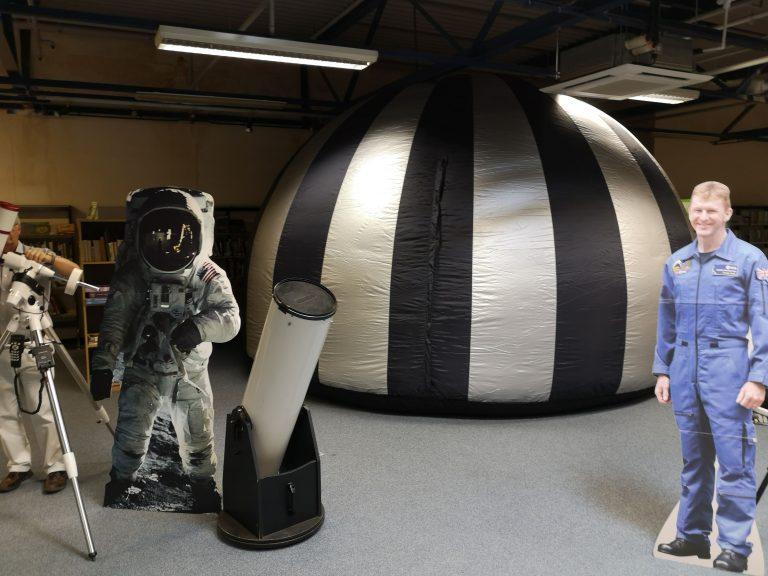
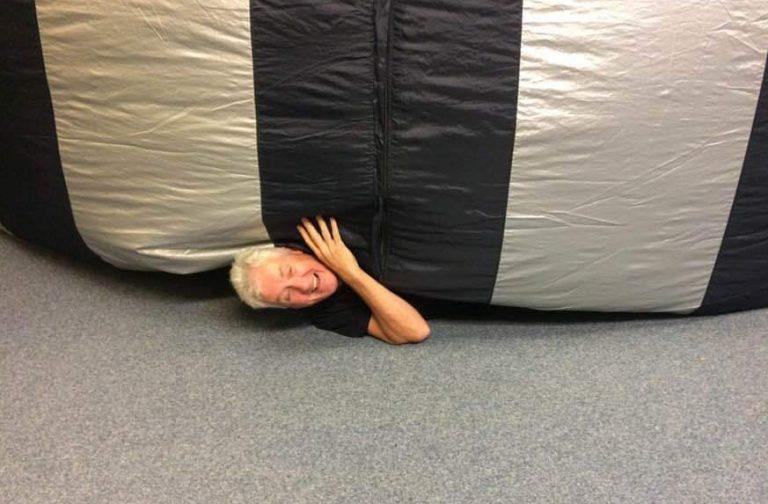
Catch me (and where there is space, the planetarium) in libraries over the #SummerHolidays.
The next outreach event with NNHS is tomorrow (8th August) at Hunsbury Library in Northampton.
Unfortunately there isn’t room for the planetarium there, but there’s lots of hands-on things to do, Augmented and Virtual Reality experiences and lots of free goodies to take away.
Come along, say “Hi”, and pick up some freebies.
I am proud to be supporting this summers reading challenge – Space Chase in libraries across Northamptonshire.
Children can sign up at their local library and read six library books of your choice to complete the Challenge.
There are exclusive rewards to collect along the way, and best of all it’s all FREE to take part!
The Summer Reading Challenge website helps you keep track of your reading all year round:
Find new books to read, take part in competitions and mini challenges, and play games.
Click the links above for more details.
Visit the Northamptonshire Libraries events calendar to find an event near you:
https://www3.northamptonshire.gov.uk/councilservices/library-service/Pages/library-events.aspx
You’ll need to book your space as these events are going to be very popular.
There will be lots of hands-on stuff for kids to get involved with, including immersive Virtual Reality tours.
These include an overview of the solar system, a flight in a Soyuz Capsule or exploring the International Space Station.
We will have lots of free leaflets packed full of space information free to take away.
For the really keen children we also have a few posters to give away.
As if that wasn’t enough, as well as helping out in some of the libraries, in libraries that have the space, I will be bringing in the planetarium.
This will give a fully immersive experience as the children and families explore the planets in our solar system.
We will experience the landing of the probe Curiosity onto Mars to begin it’s exploration of the martian surface.
At the end of the show we will then visit the International Space Station with Tim Peake as our guide.
So there’s never been a better time to get interested in space.
I hope to see lots of keen children to educate and enthral them in one of our a local libraries very soon.
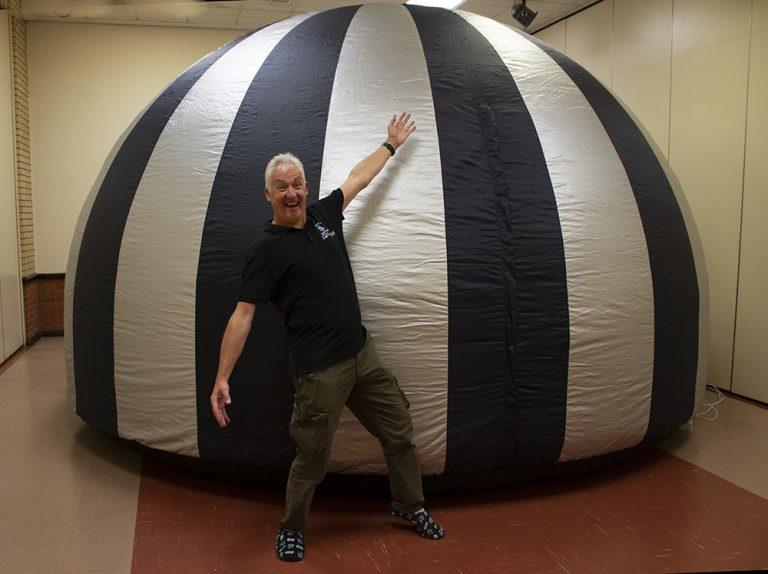
My free monthly sky diary for August 2019 showing the events of the night sky visible from the UK is now available in a printable pdf version for download.
Click here, or on the image below to download the pdf.
Just to let keep you informed, after 32 years of doing my printable sky diary, I will stop producing my printable sky diary after December. It’s been sad, and a big decision to do this, but lately it is getting difficult to fit it in with my many other commitments.
However, it’s all not bad news.
All my sky diary events are currently and will in future be added to the UK Cloud Magnets online calendar.
I will still keep this as up to date as I can.
Click here to view the UK Cloud Magnets online calendar.
This and my Blog (www.star-gazing.co.uk/Blog.html) is where I will put any new information on sky events as they become known to me.

Follow my blog here:
www.star-gazing.co.uk/blog.html
Another extremely busy day as re-entry, splashdown and recovery of crew, CM and lunar samples are all happening today.
16:21:12 – Just before re-entry occurs, the CM and SM separate.
16:35:05 – CM re-entry.
During the time the hot plasma from the heat shield surrounding the capsule means that there is no communication between the astronauts and mission control.
So it is a tense wait until contact is re-established once they are safely on the parachutes.
16:39 – Visual contact with CM established by aircraft.
16:40 – Radar contact with CM established by recovery ship Hornet.
16:44:06 – Drogue parachute deployed
16:46 – VHF voice contact and recovery beacon contact established.
16:50:35 – Splashdown (went to apex-down – Floating upside down).
16:58:15 – CM returned to apex-up position (Floating upright).
17:04 – Flotation collar inflated.
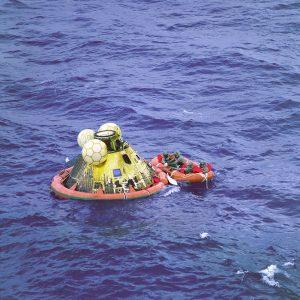
17:21 – Hatch opened for crew egress.
The astronauts were thrown containment suits to put on before they were taken off the CM.
Crazy. If there were any lunar germs around, they would have been released as soon as the capsule was opened anyway.
17:29 – Crew egress.
17:53 – Crew aboard recovery ship USS Hornet.
A sign was put up saying “USS Hornet +3”.
This ship also recovered the Apollo 12 astronauts.
17:58 – Crew entered mobile quarantine facility.
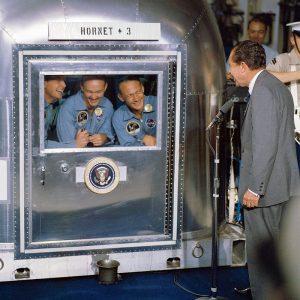
President Nixon greets them and speaks to them over a microphone.
See the video here:
https://www.youtube.com/watch?v=DjXskFHQPp0&t=585s
Go to 9m 30s in the video for when the National Anthem starts and the crew stand up saluting.
I find it absolutely hilarious. Makes me chuckle every single time.
Such a well planned dignified end to such a fantastic mission.
19:50 – CM lifted from water.
19:58 – CM secured to quarantine facility.
20:05 – CM hatch reopened.
22:00 – Sample return containers 1 and 2 removed from CM.
23:32 – Container 1 removed from mobile quarantine facility.
00:05 – Container 2 removed from mobile quarantine facility.
The mission may be over, but now the real science starts on the samples bought back.
Did you know, the astronauts had to sign a customs document when they landed?
Here a copy of it below. Don’t you just love bureaucracy?
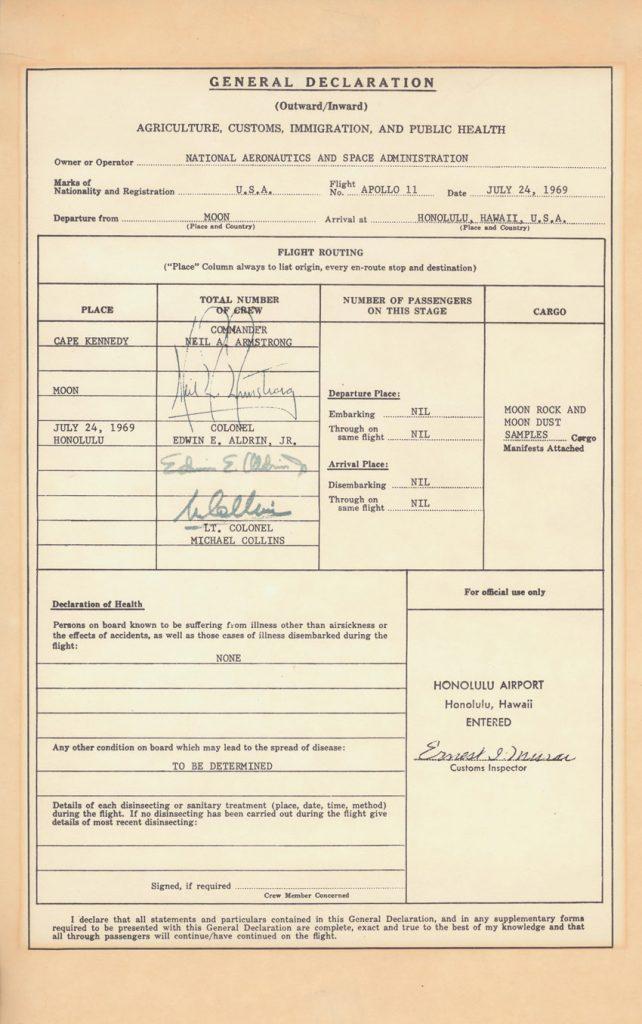

Follow my blog here:
www.star-gazing.co.uk/blog.html
Scroll down for more of the Apollo 50 timeline.
Not much for the astronauts to do today on our Apollo 11 50th timeline, apart from some housekeeping and three TV transmissions. In these the astronauts thanked the 400,000 people that helped develop the technology and build everything to get them to The Moon.
The Earth is now getting much bigger in their window as they make their approach.
All this as they travel back towards Earth and prepare for tomorrows action-packed day of re-entry.
01:08 – TV transmission started.
01:26 – TV transmission ended.
22:42 – TV transmission started.
22:45 – TV transmission ended.
23:04 – TV transmission started.
23:16 – TV transmission ended.
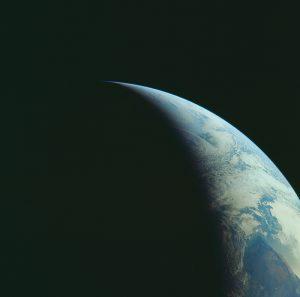
One small step for me.
Live interview with Simon Hoggarth at Northampton’s NLive Radio tonight.
http://nliveradio.com
Discussing the Apollo 11 lunar Mission and answering general astronomy questions.
Yes, the dreaded astrology word raised it’s head.
He’s selected some great space-related music to play tonight.
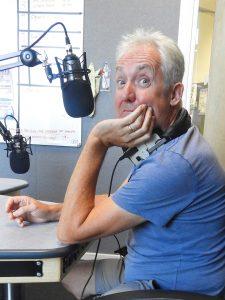
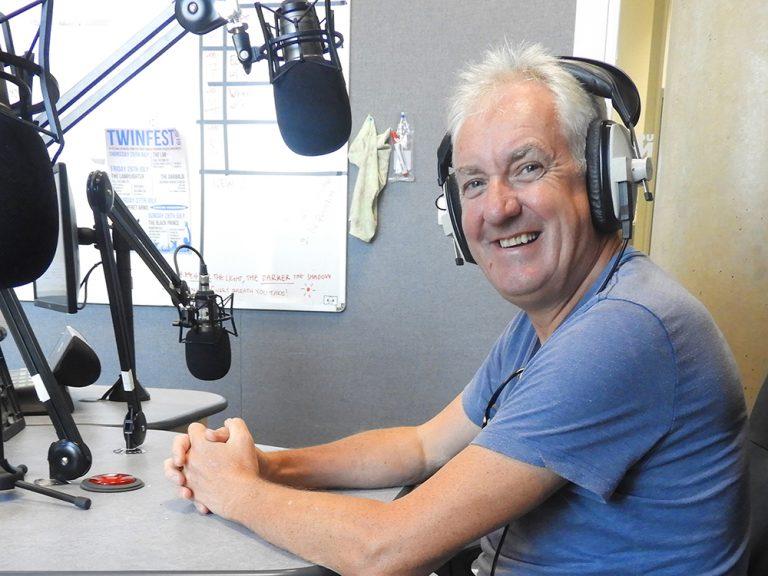

Scroll down the blog if you’re looking for today’s Apollo 11 50th Timeline.
What a great day it was for my Apollo 50th Day.
In the afternoon I did an afternoon of five planetarium shows, bringing the lunar landings to life as an immersive full-dome experience where we witnessed the landing of Eagle onto The Sea of Tranquillity.
The evening I gave two presentations about The Space Race and The Apollo Missions.
Everyone enjoyed both of the shows and it was a brilliant atmosphere.
Thank you to my willing volunteers building a scale model of the Earth-Moon system.
Well done to Corrine for winning a signed copy of Tim Peake’s book
Ask An Astronaut. (Signed by Tim, not me!).
It was the best way I could have spent to celebrate this historic moment in history.

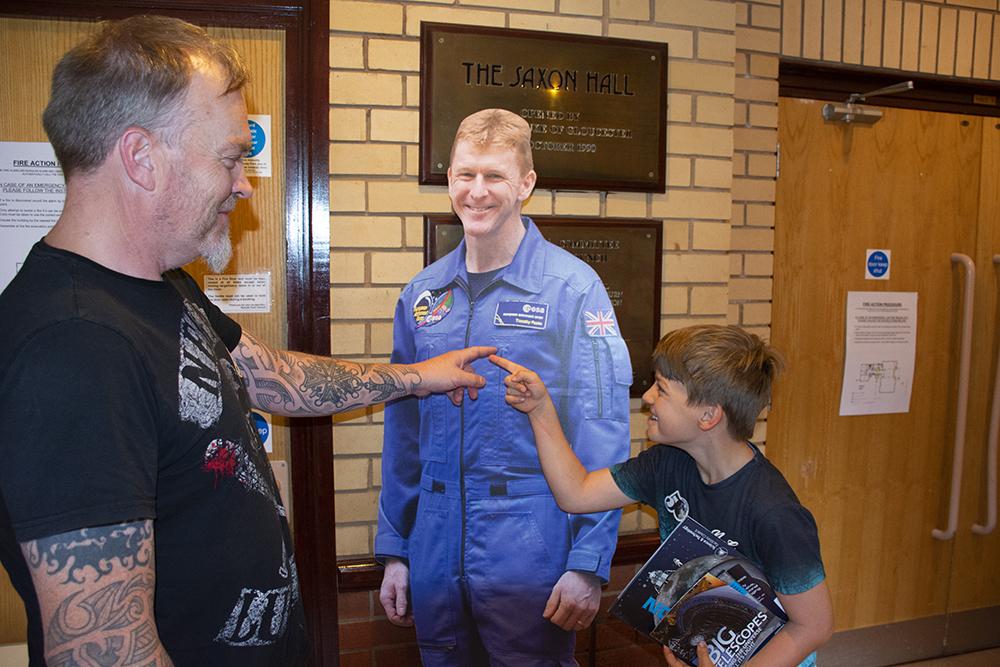
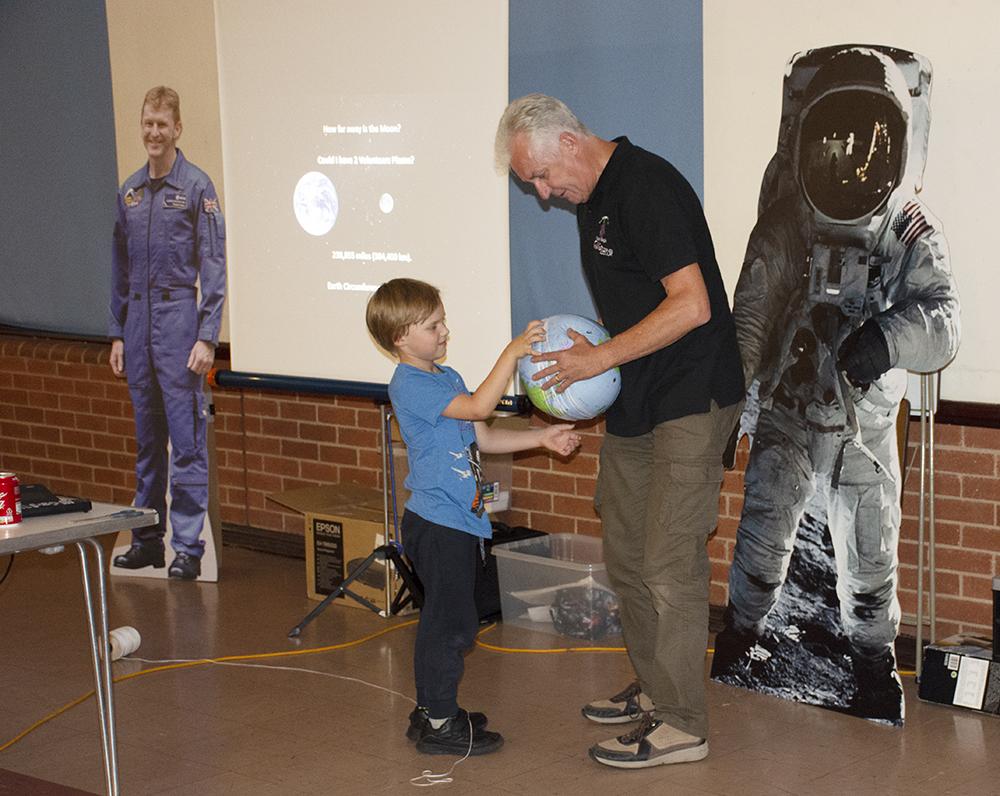
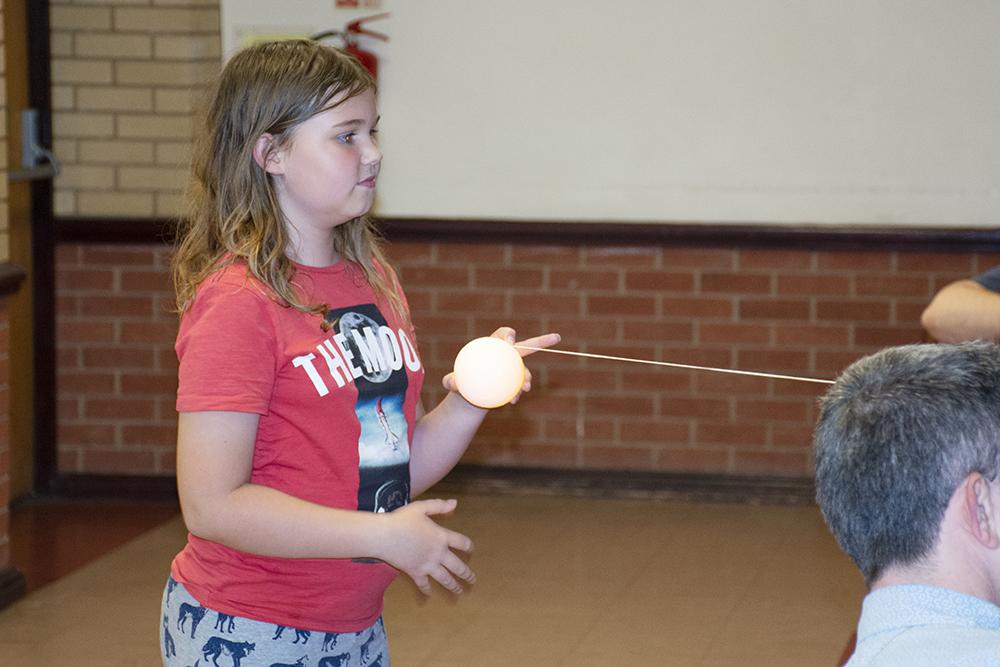

Follow my blog here:
www.star-gazing.co.uk/blog.html
A much easier day on the Apollo 11 timeline for the astronauts today as they separate from the Lunar Module, break out of lunar orbit and begin their journey back towards Earth.
00:02:01 – Command-Service_Module (CSM)/ Lunar Module (LM) final separation ignition.
00:02:08 – CSM/LM final separation cutoff.
The astronauts do two more orbits of The Moon.
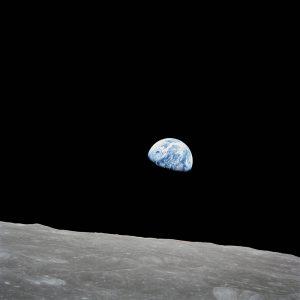
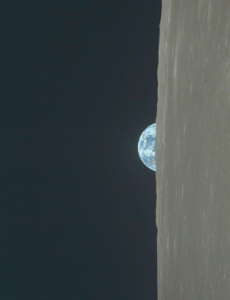
04:55:42 – Trans-earth injection ignition.
04:58:13 – Trans-earth injection cutoff.
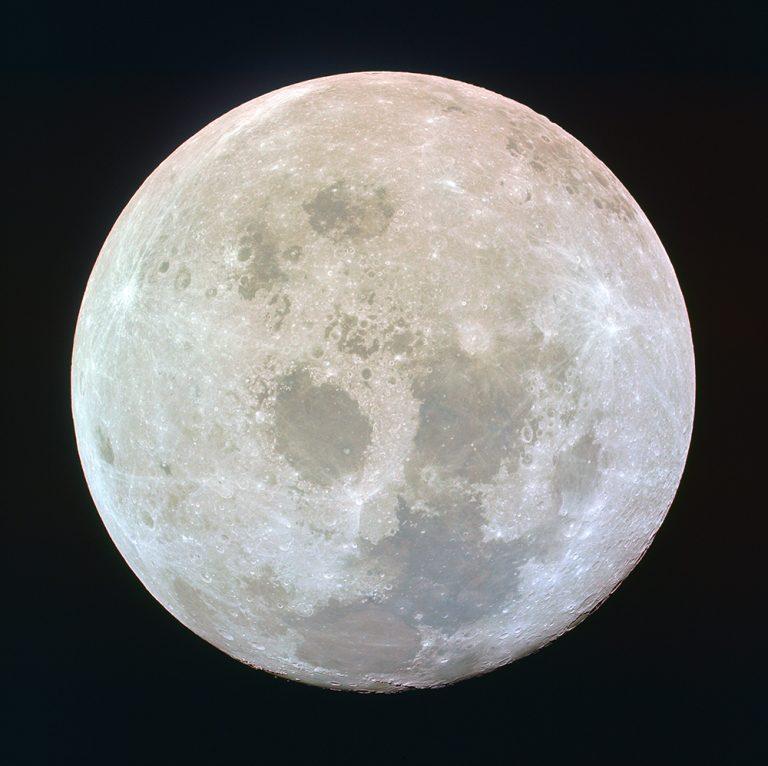
The CSM is now coasting back towards Earth.
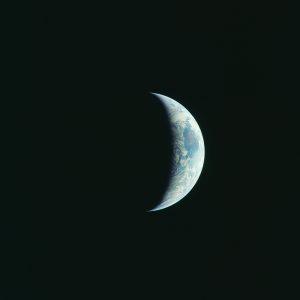
20:01:57 – Mid-course correction ignition.
20:02:07 – Mid-course correction cutoff.
The intrepid crew are now safely on their way home.
They can now watch The Moon getting smaller and the Earth getting bigger.